Horse High Withers are a prominent feature found in many breeds. This anatomical characteristic refers to the area where the neck meets the back, specifically where the shoulder blades protrude. Horses with high withers often have a more defined, upright appearance. While high withers are often associated with athleticism, they can also present certain challenges for riders and caretakers.
Navigating High Withers: Fitting and Saddling
 Horse with High Withers and Proper Saddle Fit
Horse with High Withers and Proper Saddle Fit
One of the primary considerations for horses with high withers is proper saddle fit. Due to the prominent bone structure, conventional saddles may sit too low, pressing on the withers and causing discomfort, pain, and even injury.
Key Saddle-Fitting Tips for High Withers:
- Look for a saddle with a high pommel: The pommel is the front arch of the saddle. A higher pommel provides adequate clearance over the withers.
- Consider a cut-back saddle: These saddles feature a design where the pommel and panels are shaped to avoid contact with the withers.
- Ensure adequate gullet width: The gullet is the channel that runs down the center of the saddle. Horses with high withers typically need a wider gullet to accommodate the spine and surrounding muscles.
- Seek professional saddle fitting: A qualified saddle fitter can assess your horse’s conformation and recommend the best saddle options.
In addition to saddle fit, using appropriate padding can help distribute pressure more evenly and prevent rubbing. Wither relief pads, gel pads, or sheepskin pads can be beneficial for horses with high withers.
Recognizing Potential Issues: Signs of Poor Saddle Fit
Horses often communicate discomfort through subtle cues. Recognizing the signs of poor saddle fit is crucial to preventing long-term issues.
Watch for these indicators:
- Reluctance to move forward: The horse may hesitate, pin its ears back, or refuse to go forward when pressure is applied to the withers.
- Head tossing and tail swishing: These behaviors can indicate discomfort and pain.
- Sensitivity to touch: The horse may flinch or show signs of pain when the withers are touched.
- Dry spots under the saddle pad: Uneven sweat patterns or dry spots can indicate areas where the saddle is not making proper contact.
- White hairs or sores: Prolonged pressure on the withers can cause hair to turn white or even lead to sores.
Beyond Saddles: Understanding Other Considerations
While saddle fit is paramount, other aspects of caring for a horse with high withers are equally important:
- Grooming: High withers can be prone to rubbing from blankets and sheets. Using blankets with horse blankets with neck or shoulder gussets can help prevent friction. Regularly check for signs of rubbing and adjust blankets accordingly.
- Conformation and Performance: Horses with high withers often excel in disciplines requiring agility and collection, such as jumping and dressage. However, high withers can also make it more challenging for the horse to achieve a rounded frame.
- Breed Predispositions: Some breeds, such as Thoroughbreds, Warmbloods, and Saddlebreds, are known for their high withers.
Expert Insights: Dr. Emily Carter, Equine Veterinarian
“High withers are a common conformation trait that requires careful attention to detail, especially when it comes to tack fit,” says Dr. Emily Carter, DVM. “Proper saddle fit is crucial to prevent pain and performance issues. Always consult with a qualified saddle fitter to ensure the best possible fit for your horse.”
FAQs: Addressing Common Questions
Q: Can high withers be corrected?
A: High withers are a skeletal feature and cannot be corrected. However, proper management and tack fitting can address the challenges they present.
Q: Are horses with high withers more prone to back problems?
A: Not necessarily, but poor saddle fit can put them at increased risk. Regular chiropractic care and massage therapy can be beneficial for all horses, regardless of their conformation.
Q: Can I use a regular saddle pad on a horse with high withers?
A: It’s generally advisable to use specialized pads, such as wither relief pads, to provide additional cushioning and pressure distribution.
Q: How often should I have my saddle checked for fit?
A: Horses’ bodies change over time, so it’s recommended to have your saddle checked at least annually, or sooner if you notice any changes in your horse’s behavior or back condition.
Q: Do horses with high withers need special blankets?
A: Blankets with high necks or shoulder gussets can help prevent rubbing and provide a more comfortable fit.
Q: Are certain riding disciplines more challenging for horses with high withers?
A: While horses with high withers can excel in many disciplines, they may find it more difficult to achieve a rounded frame required in some disciplines like dressage.
Conclusion
Understanding horse high withers is essential for any horse owner or rider. By prioritizing proper saddle fit, using appropriate padding, and being mindful of the unique needs of horses with this conformation, we can ensure their comfort, well-being, and performance. Remember, a well-fitted horse is a happy horse.
For more information on horse care and equipment, explore our other articles on horse in clothes and sun sheet for horses.
If you have any concerns about your horse’s withers or saddle fit, consult with a qualified equine professional.
For further assistance and expert advice, contact Justus Horses USA at:
Phone: 0772127271
Email: [email protected]
Address: QGM2+WX2, Vị Trung, Vị Thuỷ, Hậu Giang, Việt Nam.
Our dedicated team is available 24/7 to address your queries and provide exceptional customer service.